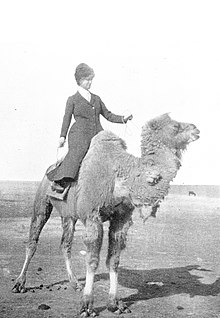Beatrix Bulstrode – Wikipedia
From Wikipedia, the free encyclopedia
|
Beatrix Timbrell Bulstrode |
|
|---|---|

Beatrix Bulstrode on a camel |
|
| Born |
Mary Beatrix Nunns 1869 |
| Died | 1951 |
| Nationality | British |
| Other names | Beatrix Manico Gull |
| Occupation(s) | Journalist and explorer |
| Known for | Travels in China and Mongolia |
| Notable work | A Tour in Mongolia |
British journalist and explorer
Beatrix Timbrell Bulstrode (born Mary Beatrix Nunns in 1869, later known as Beatrix Manico Gull after second marriage, died 1951) was a British journalist and explorer. She is best known for her journey through China and Mongolia in the early twentieth century, which she wrote about in a 1920 book, A Tour in Mongolia.
Biography[edit]
Bulstrode was born Mary Beatrix Nunns in 1869 in Sussex.[1] She later became a journalist and was on the council of the Society of Woman Journalists.[1] In 1891, she married Herbert Timbrell Bulstrode, who died in 1911.[1] Bulstrode wanted to travel after the death of her first husband.[2]
Bulstrode toured Mongolia twice.[3] The first journey used local guides and she was accompanied by a missionary from Finland.[3][4] Her second trip was with Edward Manico Gull, who she later married.[3] On her travels, she carried a concealed Mauser C96 that she was practiced in using.[5] She also had two Colt revolvers and a shotgun.[2] The entire journey cost her $1,500.[2]
Bulstrode began her journey in September 1911, starting out at Hong Kong.[2] She took a boat to Fuzhow, where she was able to tour southern China.[2] She took another boat trip to the mouth of the Yangzste River and then traveled 1,200 miles (1,900 kilometres) up the river part-way with a local crew and later on a British steamer.[2] She next traveled near Yichang and then went back to Hankou.[2] From there, she traveled to the capital, Beijing.[2] From the capital, she traveled through Zhangjiakou in a cart to Mongolia.[2] Once in Mongolia, she traveled 120 miles (190 kilometres) through open country, encountering Nomadic people.[2] Bulstrode decided not to cross the Gobi Desert and returned to Beijing.[2]
In Beijing, she met Edward Manico Gull who worked for customs in China.[2] They decided to travel to northern Mongolia together and felt they each had complementary skills needed for the journey.[2][4] They took a train to Werkneudinsk in Siberia and then traveled up the Selenga River in a steamboat.[2] They came to Kyakhta, where Russian customs held them up for some time because of their weapons and ammunition.[2] Finally, they hired a three-horse cart known as a taranta, and began their journey to the capital of Mongolia, Ulaanbaatar.[2] In the capital, she visited a “dungeon,” where she described around 150 prisoners, most with life sentences being kept in small boxes, similar to Coffins.[6] She also related an incident where she watched the execution of three soldiers from this prison.[7] Leaving the capital, they traveled by orton and reached Kyakhta.[2] Then they went back to Siberia, took the Trans-Siberian Railway to St. Petersburg and finally returned to Britain.[2]
Bulstrode published a book about her travels in 1920 called A Tour in Mongolia.[8] She begins the stories of her travels in Beijing.[4] The Washington Journal called A Tour in Mongolia a “vivid account” of her journey.[9]
Bulstrode continued to stay involved with China, working to provide relief work in that country in 1937.[10] Bulstrode died in 1951 in Surrey.[1]
-

Beatrix ready to start her journey with Dobdun.
-

Bulstrode in a Peking Cart.
References[edit]
External links[edit]
Recent Comments